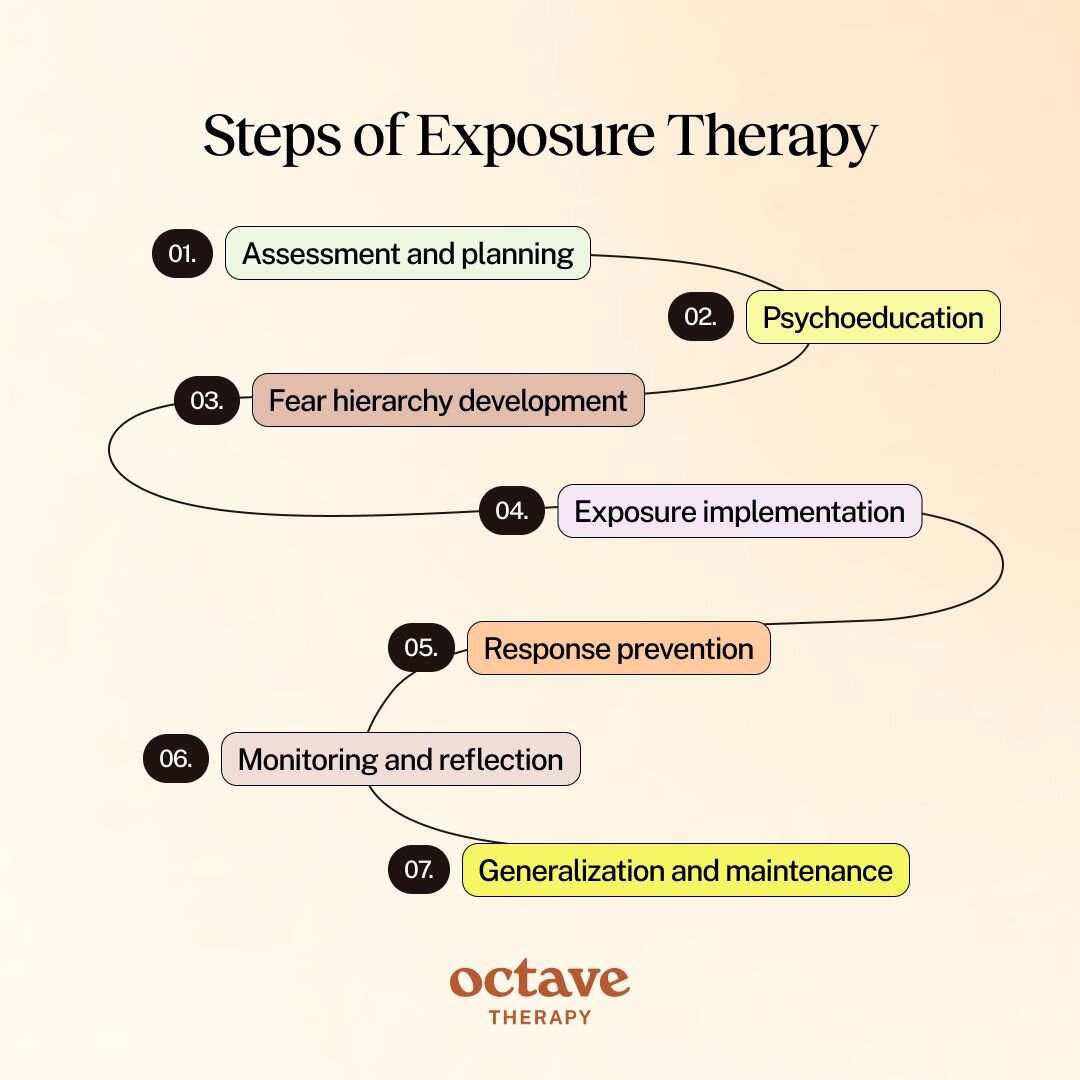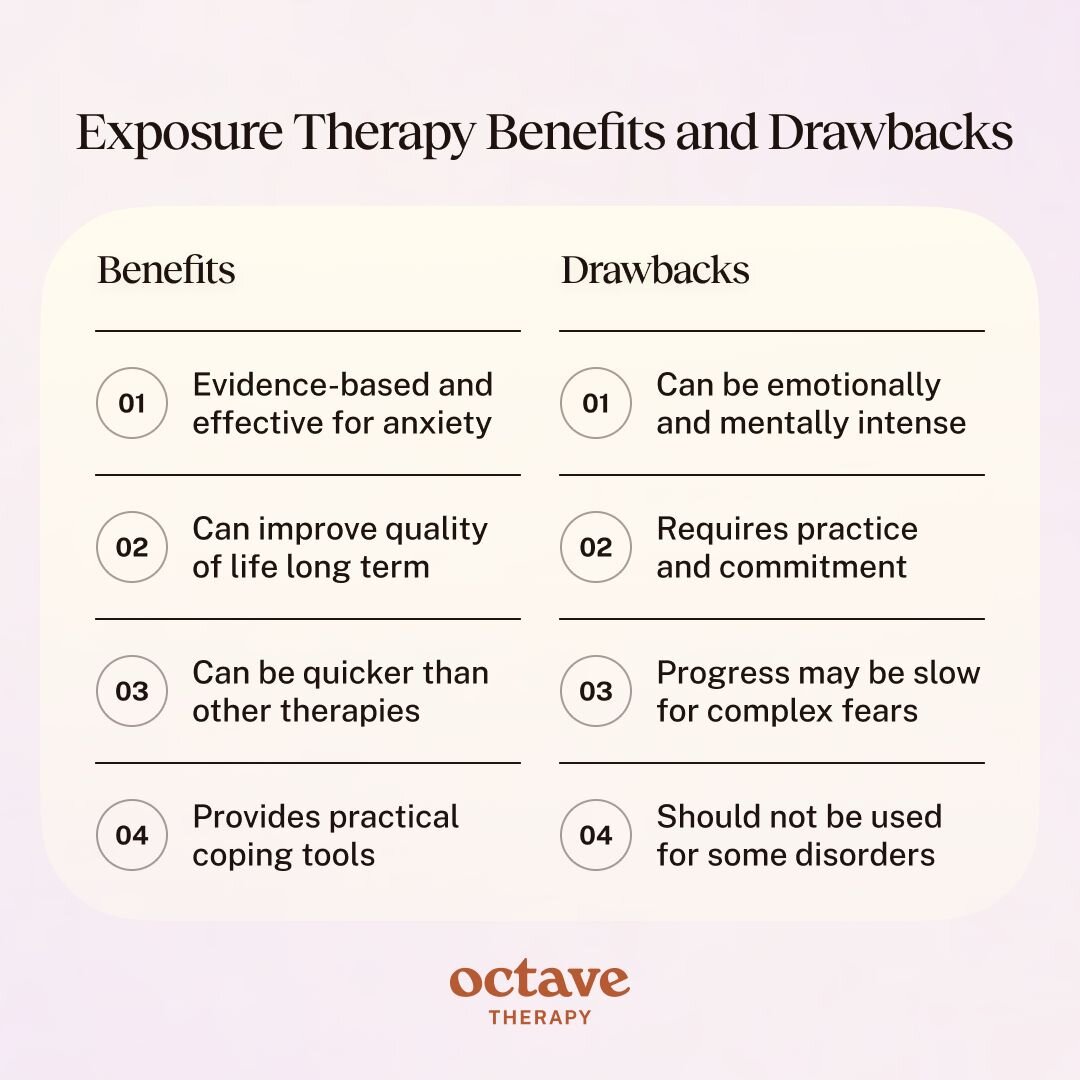
What is Exposure Therapy?
Overview
Exposure therapy is a common approach for treating a range of mental health diagnoses including post-traumatic stress disorder (PTSD), phobias, and obsessive-compulsive disorder (OCD). It involves gradual exposure to a memory, item, or place that triggers anxiety or fear.
If you’re considering exposure therapy, it is understandable if you have a sense of trepidation. However, with an understanding of what exposure therapy is and how it works, it’s possible to start the process with enthusiasm.
We won’t get far talking about exposure therapy without understanding what it is designed to treat: fear associated with certain mental health diagnoses.
Fear is a normal emotion that plays a crucial role in survival when faced with threats. Nonetheless, when excessive or inappropriate, it can severely impact a person’s ability to live a full life. Excessive fear is the primary component of a number of mental health disorders.
In therapies like cognitive-behavioral therapy (CBT), a person learns to identify and challenge fears with rational thinking. Unfortunately, challenging fears on a cognitive level is often not sufficient on its own. Research has shown that actually facing irrational fears can be a powerful way of reinforcing the rational basis for letting go of them.
Exposure therapy is designed to address the primary behavior associated with disorders like PTSD and OCD: avoidance. It is often used not in isolation, but rather as a component of CBT, as it is complemented by techniques that address the person’s thoughts and beliefs. During sessions, the therapist prepares the client to face their fear. In the safety of the therapeutic environment, the client is then gradually exposed to the memory or situation they have been avoiding.
Trying to confront a traumatic memory or greatly feared situation alone can not only be too much of a challenge, but can also be counterproductive. When the fear is triggered without adequate support and preparation, it can overpower a person’s cognitive and emotional resources, and potentially become a traumatic experience of its own. Therefore, exposure therapy should be conducted under the guidance of a licensed mental health practitioner.
How Does Exposure Therapy Work?
As mentioned, fear is a healthy emotion. It is when a person is beset by irrational fears, whether imagined or no longer relevant, that treatment becomes necessary. Exposure therapy is based on behavioral principles – the idea that behaviors are reinforced by repetition, along with the presence of positive or negative associations.
Exposure therapy changes avoidance behaviors by bringing the person face to face with fear stimuli that cannot actually harm them. These may be thoughts and memories, objects, activities, or situations.
Several common mental health disorders are treated with exposure therapy:
- PTSD: People with PTSD may fear memories of the trauma, people who were present, the place where it occurred, and other associated cues.
- OCD: The subjects of obsessive thoughts are often irrational fears, such as germs on everyday objects, having “unacceptable” thoughts, etc.
- Phobias: Common phobias include claustrophobia, arachnophobia, acrophobia (the fear of heights), and social phobia.
Often, clients’ fears have a legitimate source. However, they are irrational due to the context or because they are severely overblown. The cognitive triangle – a tenet of CBT that describes the interplay between thoughts, feelings, and behaviors – teaches that when a person changes their behaviors, all aspects of the system adapt. Exposure therapy helps a person change how they behave in relation to the fear, and when the behavior is changed, the thoughts and feelings about the feared stimulus change, as well.
At the start of therapy, the person habitually avoids the feared stimulus. Rather than reducing anxiety, however, the cycle of avoidance only reinforces it. During therapy, the client gradually faces the feared memory, object, or situation.
Initially, anxiety increases, but when the feared outcome does not occur, or the client is able to cope with the fear, the brain begins to learn that the fear response is unnecessary. With repeated exposure, the fear is diminished.
The following behavioral mechanisms are integral to exposure therapy:
- Habituation: People get used to situations when repeatedly exposed to them, and familiarity breeds a sense of safety.
- Extinction: Although our mind can make strong associations, even between unrelated items, extinction – or the weakening of these associations – is always possible.
- Self-efficacy: Humans are adaptable, and the agency gained in facing one’s fears leads to the confidence that they can cope.
- Reframing: The way a person sees and interprets something changes with new experiences.
Throughout the process, the therapist manages the individual’s experience, mitigating any risks. They implement a fear hierarchy, beginning with the least distressing fears, and progress as slowly as necessary.
Types of Exposure
What does “exposure” mean in exposure therapy?
It might be difficult to conceptualize the types of exposure used in therapy, considering that feared situations, places, and objects may not be accessible, and some fears are entirely cognitive or abstract.
For this reason, the therapist draws on what is available, whether materially or in the client’s imagination. The following types of exposure may be utilized:
- In vivo (real life): When a fear is both accessible and poses no danger, exposure to it can be done in real life (in vivo). For example, a person with OCD who fears touching doorknobs can be coached to touch the doorknob in the therapist’s office.
- Imaginal: The human imagination is extremely powerful, which is why fears can manifest in such disruptive ways. This is actually useful in treatment, as clients can visualize their fears. Someone who went through a trauma, for example, can visualize the situation or place. Someone who fears an impossible or unlikely outcome can do the same.
- Interoceptive: Interoceptive exposure refers to recreating the physical sensations of fear, such as a raised heart rate, dizziness, shortness of breath, and hyperventilating. This is achieved through methods like breathing through a straw, running on a treadmill, and spinning around in a chair. It is especially useful for people with panic disorder, whose panic attacks may seem to come on suddenly and are not connected to any specific stimulus.
- Virtual Reality: With the development of virtual reality devices, it is now possible to enter a vivid simulation of a feared environment in the therapist’s office. A person afraid of public speaking, for example, can practice in front of a realistic room full of people.
The Steps of Exposure Therapy
In order to be as effective as possible without the risk of negative outcomes, exposure therapy is extremely structured. There are multiple steps before the individual is exposed to any fears, and exposure itself is followed by further reinforcing activities.
The therapy process follows these steps:
1) Assessment & Treatment Planning
Exposure therapy starts with a thorough assessment of the client’s difficulties. It is crucial to identify the core triggers of their fears in order to directly address them. It’s also necessary to understand how the symptoms of the disorder are impacting the person’s life and what they hope to achieve in therapy.
Before planning the treatment, the therapist assesses whether exposure therapy is an appropriate approach. In certain cases, such as when symptoms of psychosis or dissociation are present, exposure therapy is not appropriate as it may increase distress or worsen symptoms.
This step should be a collaborative exploration with both the therapist and the patient. Exposure therapy relies on a high level of trust and should not proceed unless the therapist is a good fit for the client.
2) Psychoeducation
Exposure therapy is most successful when the client understands how it works. With an understanding of how avoidance reinforces fear and how exposure counteracts it, the person has a greater sense of agency and is more motivated to see therapy through if it gets difficult. They also learn that anxiety is uncomfortable but not dangerous, which is crucial if they are to feel safe.
3) Fear Hierarchy Development
By facing the least distressing fears first, clients are more likely to overcome avoidance and see the exposure process through. The therapist therefore works with the client to develop a fear hierarchy, listing fears from the least to the most distressing.
4) Exposure Implementation
With this foundation in place, the client begins to face the fears with the lowest intensity, using the most appropriate type of exposure. Depending on the specific fears and type of exposure utilized, clients may practice both in the therapist’s office and on their own between sessions.
5) Response Prevention
The therapist helps the client explore avoidance and safety behaviors that come to the fore during exposure implementation, addressing how they can prevent therapy from being effective. Clients learn skills to change their responses, such as calming techniques to regulate their emotions and not react to avoidance urges.
6) Monitoring & Reflection
Clients track reactions, anxiety levels, and implementation of coping skills after each session so as to monitor progress. The individual also reflects on how the therapy is helping and where they feel stuck.
7) Generalization & Maintenance
While exposure therapy habituates the person to no longer fear the stimulus to the same extent, reinforcement is necessary in daily life to prevent relapse. Clients therefore learn skills to generalize the benefits of therapy and maintain its effectiveness.

Benefits and Drawbacks of Exposure Therapy
If you are considering exposure therapy, it is helpful to know about the benefits and any potential drawbacks.
The good news is that, having been proven effective in multiple studies, exposure therapy has many benefits. That being said, as with any health treatment, it does have some drawbacks that may impact your decision.
Benefits
The benefits of exposure therapy include:
- There is a strong evidence base for its effectiveness in treating anxiety disorders, OCD, PTSD, and phobias.
- Having confronted their root fears, people who complete exposure therapy tend to show long-term improvement.
- The reduction in avoidance behaviors and increase in confidence can lead to a substantial improvement in quality of life.
- It can be quicker than other therapies due to its very direct approach.
- Exposure is paired with practical coping tools that remain useful long after therapy is complete.
- It is often covered by insurance as a part of CBT.
Drawbacks
The drawbacks of exposure therapy may include:
- It is emotionally intense, sometimes increasing distress in the initial phases.
- Commitment and regular practice is required, even between sessions.
- Some disorders, such as psychosis and untreated trauma, should not be treated with exposure therapy.
- Misuse or poor implementation may worsen symptoms.
- For people with complex or layered fears, progress may be slow.
A good therapist will help you assess whether exposure therapy is appropriate and can answer any questions about the input that will be required from you.

Research on Exposure Therapy
Extensive research on exposure therapy has consistently shown it to be highly effective across various disorders. Specifically, studies indicate its impact when treating the following issues:
- Specific phobias: Symptoms of phobias are significantly reduced, even in a one-session treatment.
- Obsessive-compulsive disorder (OCD): Exposure and response prevention, a specialized form of exposure therapy for OCD, is effective as a first-line treatment.
- Post-traumatic stress disorder (PTSD): A meta-analysis of 65 research papers found significant improvements in individuals with PTSD.
- Panic disorder: The use of interoceptive exposure therapy is effective in treating panic disorder.
In addition to the extensive research on the effectiveness of exposure therapy, emerging research suggests that treatment is set to become even more effective. Virtual reality exposure therapy (VRET) shows a great deal of promise, with studies suggesting that it is as effective as in vivo exposure. It may become the new gold standard in treating social anxiety disorder.
Importantly, research indicates that exposure therapy is particularly effective when used in the context of CBT. The additional tools practiced in CBT ensure that the results of exposure therapy are maintained and can impact all areas of the person’s life.
Find an Exposure Therapist with Octave
Finding the right exposure therapist can feel like an intimidating prospect. After all, they will be guiding you through experiences that currently cause you fear. As such, it is essential to know what you should be looking for.
Any therapist you consider should be a fully licensed mental health professional. This means that not only have they had an intensive education in human psychology, but they’ve also had training in therapeutic practice and completed thousands of hours of therapy.
With exposure therapy, it is important to find a therapist who specializes and is experienced in this approach. Exposure is an effective treatment when used with the careful consideration and skill that specialists can provide.
How you feel about the therapist is another crucial factor to consider. This therapy requires a high level of trust, and your personal experience of the therapist should not be undervalued.
Choosing to go through Octave makes the process much easier. Every Octave therapist is fully licensed and has extensive experience. They have been carefully vetted with comprehensive assessments and background checks.
Questions to Ask an Exposure Therapist
When you meet an exposure therapist for the first time, how do you know if they’re a good fit? In addition to paying attention to how you connect with them, here are some questions you can ask:
- What disorders do you specialize in treating?
- Which types of exposure do you use (e.g., in vivo, interoceptive, imaginal)?
- Will we develop a fear hierarchy together?
- How many sessions will I need?
- Do you integrate other CBT strategies, or other therapies, with exposure techniques?
- What should I expect emotionally during and after sessions?
